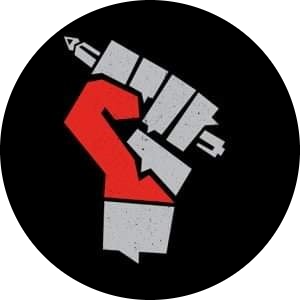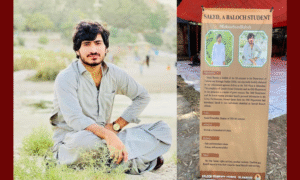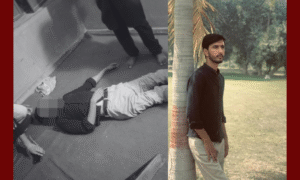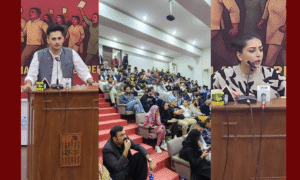The departure of US forces from Afghanistan, followed by the Taliban’s ascension to power, marks the conclusion of a terrible chapter in the country’s history. Much has been said about the desperate situation of the Afghan people now crushed under the heel of the reactionary, dictatorial Taliban, and about the role of foreign meddling in the region that it’s easy to forget that Afghanistan has had a rich indigenous history of progressive forces. This article is about that often-overlooked side of the history of Afghanistan.
One might agree with the Indian historian, Vijay Prashad that for a decade, the Afghan people have struggled between two visions of their society—one that saw the enormous need to transform and advance society through land reforms, literacy campaigns & women’s emancipation, and another that saw the future in the past and insisted on the most conservative views dominating social life.
For the sake of this article, we shall concentrate on the sociopolitical trends that emerged following King Mohammad Zahir Shah’s downfall in 1973.
Afghanistan in 1973 was a semi-feudal state, where real political power lied with landlords who lived in forts in the countryside. According to some estimates, over 75 percent of the land was owned by big landlords, who comprised only 3 percent of the rural population. In July 1973, while King Zahir Shah was on a holiday in Europe, Daud ousted him in a bloodless coup. Leading members of the PDPA and some sections of the army supported the new regime.
Daud’s rule over the next 5 years, proved to be quite autocratic and corrupt. The former British ambassador to the USSR and author, Rodric Braithwaite noted that while the new government removed the monarchy, Daud’s administration was even more autocratic and repressive than that of his predecessor. According to Daud’s intelligence, both Muslim youth organisations and radical Communist forces were plotting his demise, thus the government cracked down on dissent from both sides of the political spectrum. The state restricted the freedom of political parties and student organisations. Hundreds of political arrests occurred, and by the 1977 constitution, the government had effectively transformed Afghanistan into a presidential one-party state. (Braithwaite, 2011, p. 31)
The enormous protest in front of the presidential palace in 1978 was the final nail in the coffin for the unpopular regime. The PDPA (People’s Democratic Party of Afghanistan) deposed Muhammad Daud in a communist coup (otherwise known as the “Saur Revolution”). The new government, led by Noor Muhammad Taraki, aimed to modernize Afghanistan by enacting radical reforms; however, many of the policies proved divisive and alienating to the country’s predominantly rural and uneducated populace. At the time of the communist coup in 1978, the literacy rate in the country was only 17.8%, the numbers for women were even more abysmal. (Prashad, 2021)
The Taraki administration legalized labor unions, conducted a huge literacy drive, took efforts to free women from tribal bondage, and started a massive land reform program. Officially, women in Afghanistan enjoyed greater rights than they ever had. The PDPA made forced marriages and children marriage illegal; it imposed a limit on the dowry paid to the bride’s family to discourage the exchange and purchase of young girls.
Nancy Hatch Dupree, the Afghan historian quotes the People’s democratic party of Afghanistan’s Decree #7 which claimed to guarantee:
“Entitled dowry (Mahr) and marriage expenses, its stated purpose was to ensure that “equal rights of women with men and in the field of civil law and for removing the unjust patriarchal feudalistic relations between husband and wife for the consolidation of further sincere family ties.” (Dupree, 1981, p. 10)
The stipulations of Decree No. 7 had a greater influence on the tribal, feudal structure of rural Afghan society than any of the prior reforms. Under the Pashtun tribal code, women were viewed as property, first of their fathers and then of their husbands. The tribal law twisted the Islamic provision for Mehar, initially a payment given in marriage to the woman by her husband and meant as a type of security should he die or divorce her. It was paid to the bride’s family in Afghanistan, thereby turning women into commodities in rural property transactions.
While the new Marxist government wanted to transform a mostly feudal country into a just, egalitarian one, the communists were very well aware that a lot of the conservative people of Afghanistan won’t welcome these new ideas. Many of the fundamentalist mullahs were landlords, and they vehemently opposed the land reforms. In the mosques, they encouraged the farmers to oppose the government’s plans because according to them it was only Allah who could grant land to them. (Ryan et al., 2021)
With President Carter’s approval, the CIA, Pakistan, and Saudi Arabia officially began providing military aid and training to Muslim ‘freedom fighters’ known as the mujahideen on July 3, 1979. Tens of thousands of CIA-trained and equipped mujahideen were disrupting the state, destroying schools, and murdering instructors. Teachers who were discovered with females in the classroom were slain and even disemboweled in front of the pupils.
In response to all of this, the PDPA started a reign of terror; landowners, mullahs, military officers even the communist party officials themselves were arrested, imprisoned, and sometimes even shot.
These factors along with the already unpopular reforms further alienated the mostly rural Afghani populace and helped the CIA-backed mujahideen and foreign mercenaries in undermining the government. (though contrary to popular opinion, the mujahideen were engaged in proxy conflicts in Afghanistan even before the Saur revolution).
In 1979, the besieged government asked the USSR to intervene militarily to ward off the mujahideen. Deploying troops represented a commitment of a more serious and politically dangerous sort. It took repeated requests from Kabul before Moscow agreed to intervene militarily, and thus the chapter of the Soviet invasion started. (Parenti, 2008)
The Soviet invasion provided a perfect opportunity for the CIA to transform the tribal resistance into a holy war, a jihad to expel the godless communists from Afghanistan. The US and Saudi Arabia spent around $40 billion on the war in Afghanistan. The CIA and its allies recruited, supplied, and trained almost 100,000 radical mujahideen from forty Muslim countries.
The Soviets withdrew from Afghanistan in 1989, after a lengthy and ultimately unsuccessful war. The war had caused enormous human misery; 1-1.5 million Afghans had perished, as had thousands of Soviet soldiers. The conflict depleted the Soviet economy and gravely questioned the country’s professed anti-imperialist stance.
The PDPA government and the subsequent Soviet invasion failed to transform the semi-feudal Afghani society into a modern, egalitarian one. While the Marxist government started a mass literacy program for women along with many progressive reforms, particularly for the women in urban centers. Rural, uneducated, and particularly religious Afghans, meanwhile, rejected the PDPA’s modernization programs on cultural, religious, and economic grounds.
They especially loathed the attempts of the government to change the position of women within their cultural groups. Many such Afghans organized into armed resistance groups, even before the Soviet or American intervention. The Soviet invasion further exacerbated Afghanistan’s poverty, which was already one of the world’s poorest countries.
Even with the help of the Red Army, the PDPA government was never in complete cover over the country, in fact, the government only had power in the major urban centers. As narrated in Halliday & Tanin’s The Communist Regime in Afghanistan 1978-1992: Institutions and Conflicts:
“A sober overall assessment of this situation was given by top Soviet officials at a meeting of the CPSU Politburo in 1986. Marshal Akhromeev pointed out that the Kabul regime now had substantial military forces at its disposal: 160 000 in the army, 115 000 in the Sarandoy and 20 000 in the security organs. The problem, he argued, was that military strength was not matched by political results: ‘At the Centre there is power, but in the provinces it is not there. We control Kabul and the provincial centers, but we cannot establish an authority in conquered areas. We have lost the struggle for the Afghan people. A minority of people supports the government’.” (Halliday & Tanin, 1998, p. 1367)
The PDPA government was eventually overthrown in April 1992, and with Najibullah’s fall, all prospects for the continuance of social reforms were lost. The Office of Research and Decrees of the Supreme Court of the Islamic State of Afghanistan—the mujahideen’s government—stated in 1993 that “women need not leave their houses at all.” “Schools are whorehouses and center’s of adultery and debauchery,” the Decree read. (Prashad, 2021)
The victorious mujahideen, who now formed a major part of the current Afghan government fell into infighting, conducted mass looting and rape campaigns. According to Amnesty International, the mujahideen used sexual assault as a “means of terrorizing conquered communities and rewarding troops”. Ultimately, the Taliban (An extremist Sunni sect of the mujahideen) took over the country by force in 1996.
The Taliban, after coming to power established an extremist, atrocious reactionary regime. They started enforcing an even stricter interpretation of Islamic law. Women were ordered to wear the burqa, which covered them from head to toe, while all males were expected to have untrimmed beards.
Theocratic authorities would brutally lash women fleeing an abusive household or accusing their husbands of marital abuse. Taliban excluded women from social life, most types of medical treatment, all levels of education, and any possibility of working outside the house. The Taliban declared a virtual war on women.
As the researcher, John Ryan writes:
“Thousands of women were dismissed from their jobs as teachers, doctors, professors, and work of all kinds. They were then not allowed to participate in the workforce or even have doctors treat them (without a male relative present), and girls were forbidden to go to school. Terror, in all its forms, became the basis of the regime—a regime of fascist Muslims, but it was a regime that was kept in power largely by Pakistan.
Despite the atrocities of the regime, they initially had support in the Clinton administration because it was thought that the Taliban would bring in “stability” which would enable the construction of oil and natural gas pipelines through the country.” (Ryan et al., 2021)
And the rest, as they say, is history. Only a month after the events of September 11, the American empire started a full-fledged assault on Afghanistan. Thousands more Afghans were murdered in the years that followed. Many people perished as a result of malnutrition, cold, a lack of shelter, and a shortage of water, in addition to those killed by cruise missiles and landmines.
With the present state of events, it is easy to feel pessimistic about the whole situation and accept Afghanistan’s existing socio-political structure as it is, but beneath the ruins of today’s Afghanistan is the hope that remains in the hearts of those who want a better future for humanity. In the heart of those, who value human lives over imperialist interests and mere geopolitical gains. A better world for the Afghan people in which they aren’t just pawns in the ‘greater game’ must be realized.
Works cited:
Braithwaite, R. (2011). Afgantsy: The Russians in Afghanistan 1979–89 (1st ed.). Oxford University Press.
Dupree, N. H. (1981). Revolutionary Rhetoric and Afghan Women. Afghanistan Council, Asia Society.
Halliday, F., & Tanin, Z. (1998). The communist regime in Afghanistan 1978–1992: Institutions and conflicts. Europe-Asia Studies, 50(8), 1357–1380.
Parenti, M. (2008, December 2). Afghanistan, Another Untold Story. Common Dreams. https://www.commondreams.org/views/2008/12/02/afghanistan-another-untold-story
Prashad, V. (2021, August 22). Afghanistan’s long struggle with reforms and conservativism.
Frontline.
https://frontline.thehindu.com/cover-story/afghanistans-long-struggle-with-reforms-and-conservativism/article36036857.ece?__cf_chl_captcha_tk__=Fbgwf15p1My5N2FPVUeNLVy0KS2aNGY1De0AonIC9pQ-1636742633-0-gaNycGzNF6U
Ryan, J., Ryan, J., & Ryan, J. (2021, August 11). Afghan Tragedy: Still Relevant Today As It Was Analyzed 15 Years Ago.
CovertAction Magazine.
The Students’ Herald News Desk focuses on reporting the latest news regarding student politics and campus updates to you.
The News Desk can be reached at admin@thestudentsherald.com




